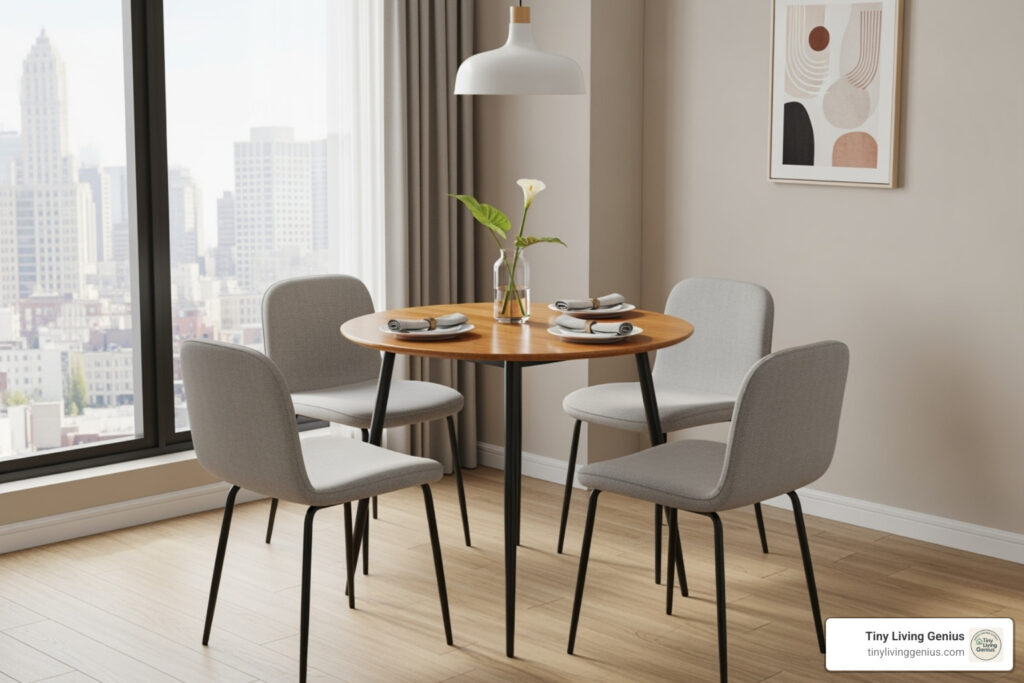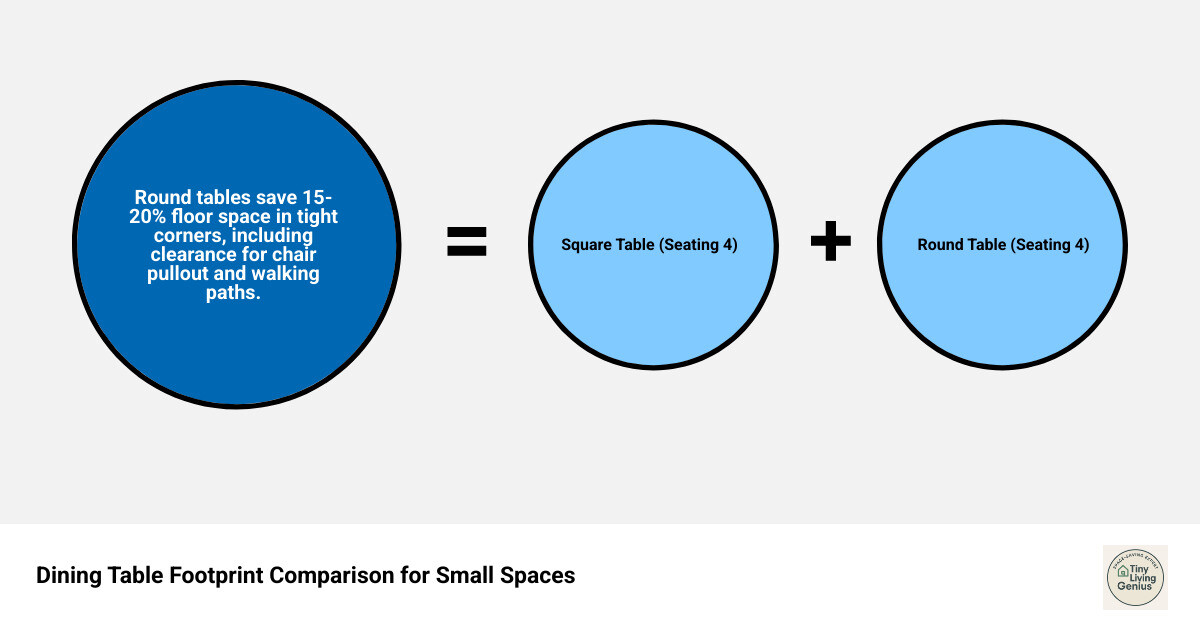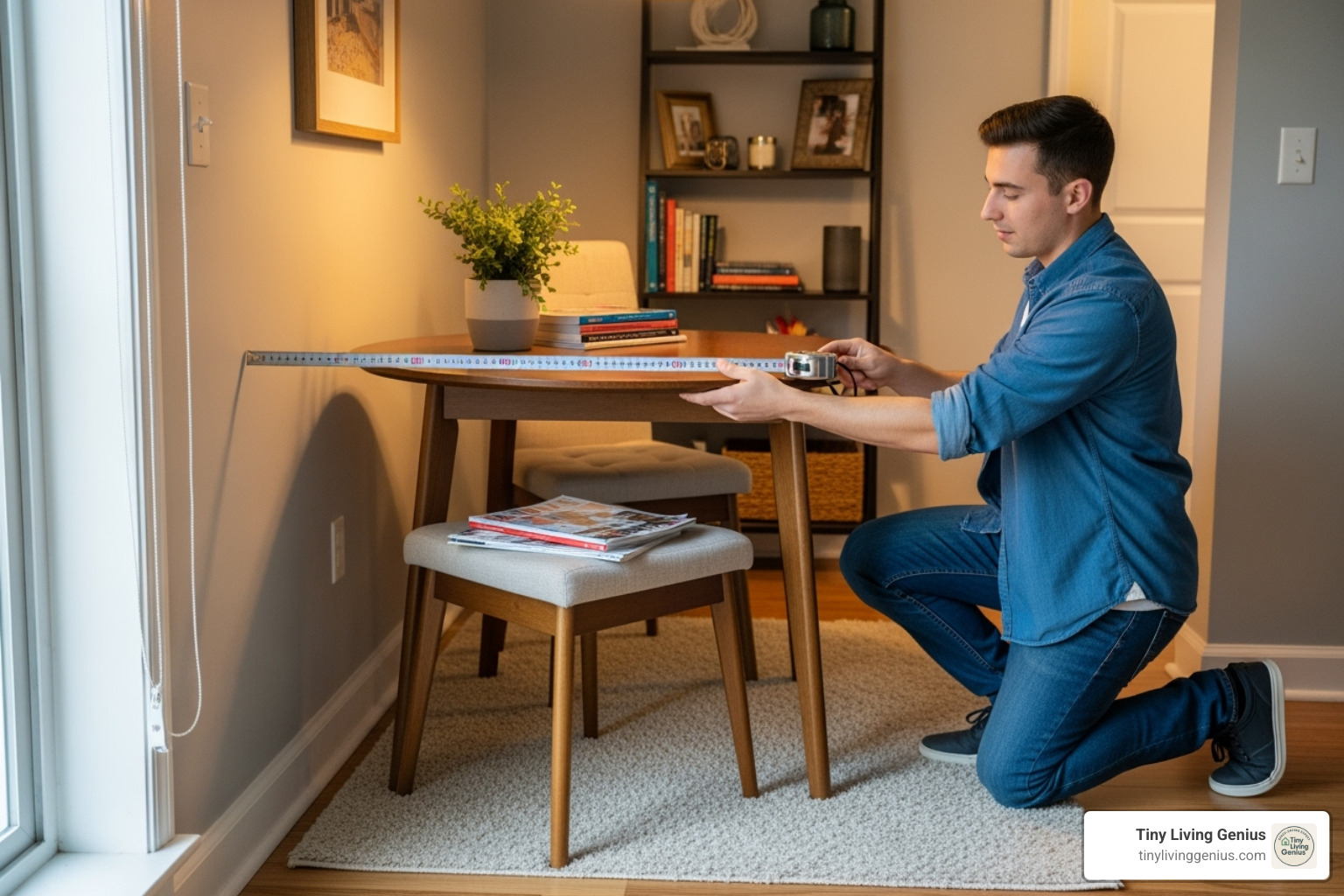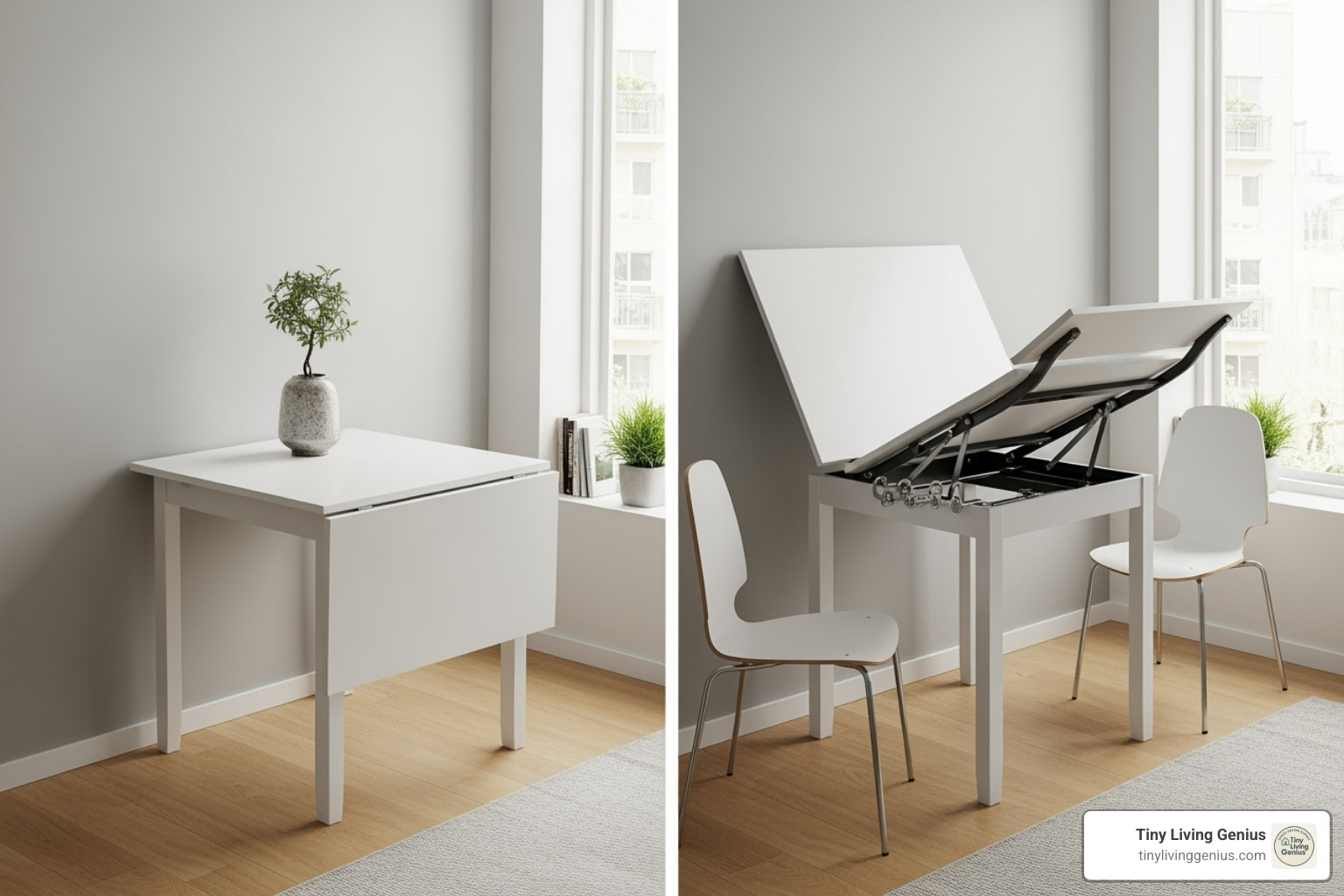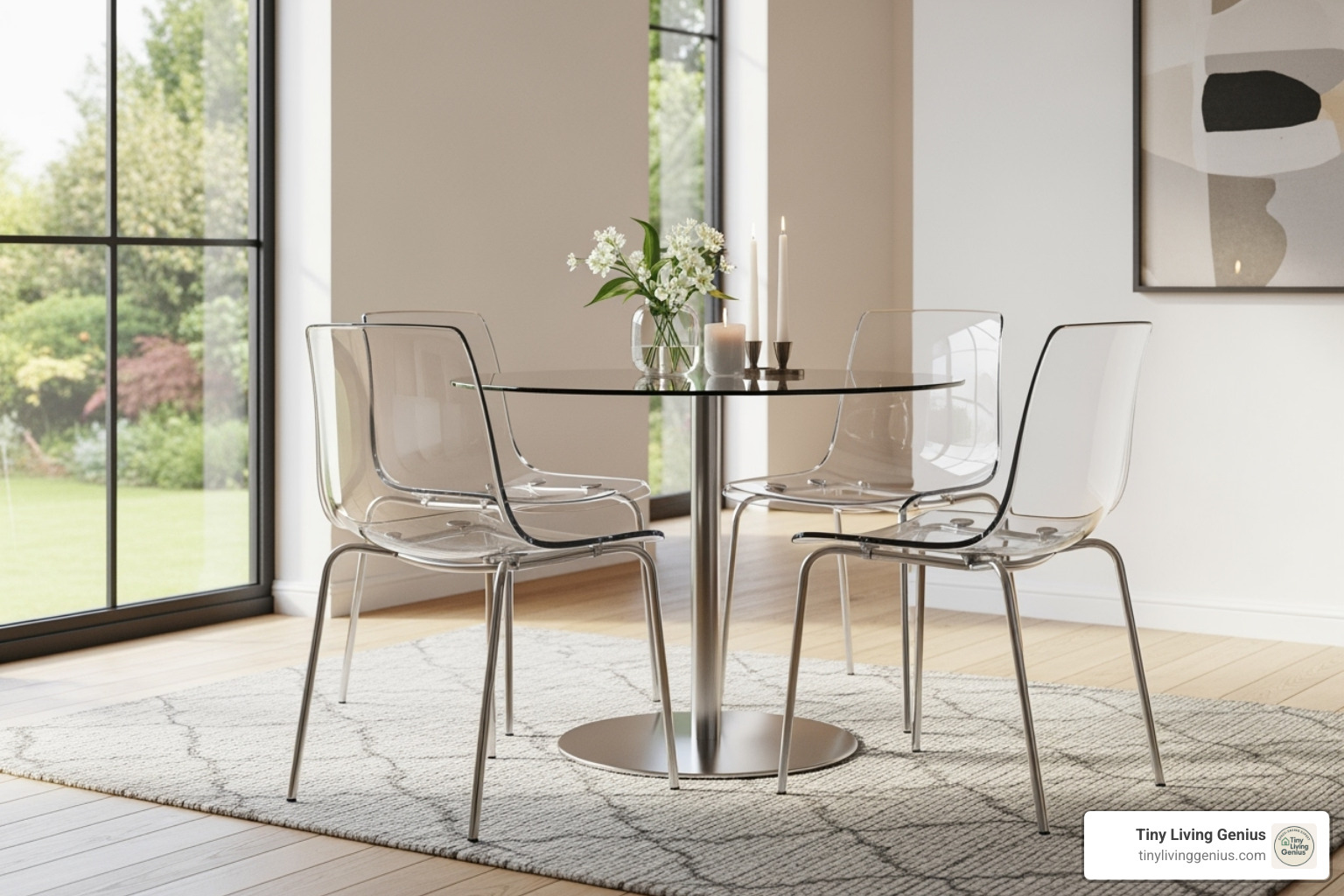Dining table for small place: Top 4 Smart Designs
Why Finding the Perfect Dining Table for a Small Place Changes Everything
A dining table for small place living isn’t just furniture—it’s the key to changing a cramped space into a functional home you love. In a small apartment, every piece must work hard, and a bulky table can dominate the room. The right one creates a dedicated eating zone, offers flexibility for guests, and even provides hidden storage, all without making your home feel like a shoebox.
Quick Answer: Best Dining Tables for Small Spaces
- Round tables – Fit tight corners, no sharp edges to steer
- Drop-leaf tables – Expand when needed, fold down when not
- High-top tables – Create illusion of more space through vertical design
- Wall-mounted tables – Fold completely away for maximum flexibility
- Extendable tables – Seat 2-4 daily, accommodate 6+ for guests
- Tables with storage – Built-in shelves or drawers reduce clutter
The challenge is finding a table that fits your room, seats your household, and matches your style. Whether you have a studio, a kitchen nook, or a multi-purpose living area, the right table transforms how you use your space.
I’m Ramy Saber, founder of Tiny Living Genius. With a background in civil engineering and years of researching smart furniture, I’ve helped countless people find the perfect dining table. Let me guide you through choosing, measuring, and styling a table that maximizes your compact home.
Why Size and Shape Are Crucial for Small Dining Areas
In a small space, choosing the right dining table for small place is about strategy, not just aesthetics. Your table’s size and shape determine whether your space feels functional or frustrating. The wrong table blocks pathways and makes a room feel awkward, while a well-chosen one maximizes floor space, improves traffic flow, and helps create distinct zones in an open-concept layout.
How to Measure Your Space Correctly
Before buying, grab a tape measure to avoid furniture heartbreak. The biggest mistake is measuring for the table but forgetting the space around it.
First, define your dining zone, using painter’s tape on the floor if needed. Then, measure the length and width of this area to get your maximum dimensions.
Next, factor in clearance space. You need at least 36 inches between the table’s edge and any wall or furniture for a comfortable walkway. For seating, allow 24 to 30 inches behind each chair so people can pull them out easily. Don’t forget to consider your home’s natural traffic flow—your table shouldn’t create an obstacle course.
If you’re considering an extendable or drop-leaf table, measure the space with the table both compact and fully extended to ensure it fits. For more guidance, check out our guide on How to Choose the Right Furniture for Your Small Space: A Comprehensive Guide.
Choosing the Best Shape for Your Room
Shape is more than style; it’s about function in a compact room.
- Round tables are ideal for small spaces. With no sharp corners, they improve traffic flow and create an intimate feel. They fit perfectly in square rooms or tight corners.
- Square tables are efficient for breakfast nooks or seating two to four people. They can be pushed against a wall to save space when not in use.
- Oval tables offer the surface area of a rectangle with the soft edges of a circle, making them great for narrow rooms.
- Rectangular tables can work if they are narrow. Push one against a wall as a console, then pull it out for dining. This shape is also common for extendable tables.
Don’t overlook the base. Pedestal bases are game-changers, as they eliminate corner legs, allowing you to squeeze in more chairs and providing better legroom. Chairs can also tuck in more neatly, making the space feel larger. For more ideas, explore our Creative Furniture Solutions for Small Spaces.
Smart Designs: The Best Types of Dining Table for a Small Place
A dining table for small place living needs to be clever and adaptable. The smartest tables transform to fit your life, expanding for guests or folding away to create more floor space. These designs are secret weapons against a cramped apartment.
Drop-Leaf & Extendable Tables: The Ultimate in Flexibility
These tables offer a compact footprint for daily life and expand for guests. A drop-leaf table features hinged sections that can be lifted to increase surface area. The dual drop-leaf style is particularly useful, with some models including hidden storage for chairs or linens. You can see examples of dual drop-leaf tables to understand how they work.
Extendable tables offer similar flexibility. A butterfly leaf design cleverly hides the extra leaf inside the table. Other models use storable inserts. The result is a table that seats 2-4 people daily but can accommodate 6-8 for special occasions. This seating flexibility is why extendable dining tables are so popular. For more ideas, see our 10 Foldable Furniture Ideas for Small Apartments.
High-Top & Bar Tables: A Stylish Dining Table for a Small Place
High-top and bar tables create an illusion of spaciousness by drawing the eye upward. This vertical emphasis makes a room feel taller and more open. Counter-height tables (34-36 inches) are great for casual meals and extra prep space, while taller bar-height tables (40-42 inches) create a bistro vibe. Paired with stools that tuck underneath, they offer a clean, multi-functional setup for eating, working, or entertaining. Learn more about using vertical space in our guide on Maximize Vertical Space in Small Spaces.
Wall-Mounted & Folding Tables
For truly tight spaces like studios, wall-mounted and folding tables are game-changers. Wall-mounted tables attach to the wall and fold down flat, disappearing when not in use. Some even include shelving. Folding tables offer similar flexibility without the installation, easily stored in a closet or behind a door. Both options allow you to reclaim valuable floor space for other activities. Find more inspiration in our Best Furniture Ideas for Small Spaces.
Tables with Built-in Storage Solutions
A dining table for small place living can also help you get organized. Pedestal tables with shelves or drawers in the base are perfect for stashing placemats, cutlery, or cookbooks. Some tables even feature built-in wine racks or storage for folding chairs. By integrating storage, you eliminate the need for extra furniture like sideboards, saving floor space and reducing clutter. For more tips, dive into our Smart Storage Solutions for Small Spaces.
Material and Styling Tricks to Maximize Your Space
The materials and styling of your dining table for small place can dramatically influence how spacious your room feels. These elements are secret weapons that trick the eye, creating a sense of openness and light without physically changing your square footage.
Material Considerations for a Dining Table in a Small Place
A table’s material affects its “visual weight”—how bulky it looks. Lighter materials create breathing room, while heavier ones can make a space feel cramped.
| Material | Durability | Visual Weight | Maintenance | General Price Range |
|---|---|---|---|---|
| Solid Wood | Very durable, can be refinished | Heavy | Requires occasional polishing, can scratch/dent | Medium to High |
| Wood Veneer | Moderate, susceptible to moisture damage | Medium | Easy to wipe clean, avoid harsh chemicals | Low to Medium |
| Glass | Durable, scratch-resistant (tempered) | Light/Invisible | Shows fingerprints and smudges, easy to clean | Medium |
| Acrylic | Moderate, can scratch easily | Light/Invisible | Easy to clean, requires gentle cleaners to avoid haze | Medium |
| Metal | Very durable, rust-resistant (coated) | Medium to Heavy | Easy to wipe clean, can dent | Low to Medium |
- Solid wood is durable and warm but has a heavy visual presence. If you love the look, explore classic solid wood designs but be mindful of size.
- Wood veneer offers the look of wood but is lighter in weight and cost, though less durable.
- Glass and Acrylic are game-changers. Their transparency creates an immediate sense of openness by not blocking the view of the floor, making the room feel bigger.
- Metal offers a sleek, contemporary look. Thin metal legs can appear light and airy, while a solid top feels more substantial.
Styling Tips to Create the Illusion of Space
Styling can improve the sense of openness or make a space feel cramped. The goal is to create the illusion of more room.
- Use light colors and reflective surfaces: Light-colored furniture (whites, creams, light woods) reflects light, making the space feel brighter. Mirrors and metallic finishes also help.
- Choose the right chairs: Armless chairs tuck neatly under the table. Transparent acrylic chairs are almost invisible, creating an airy feel. Benches and stools are also great space-savers that can be pushed completely underneath. Our research confirms that chairs that fit under the table maximize free space.
- Add strategic lighting: A pendant light above the table defines the dining zone without using floor space. Choose a fixture that isn’t too bulky.
- Keep centerpieces minimal: Opt for a simple vase or a few candles to keep the surface from feeling cluttered.
- Define the zone with a rug: In an open-concept space, a rug under the table can visually separate the dining area. Ensure chairs stay on the rug when pulled out.
- Stay clutter-free: A clean table and surrounding area will always feel more spacious.
For more strategies, check out our Tiny Apartment Design: Ultimate Guide.
Frequently Asked Questions about Small Dining Tables
When living in a small space, questions about making dining work are common. Here are answers to the most frequent questions we receive about choosing a dining table for small place living.
How many people can a small dining table typically seat?
It depends on your daily needs. The smallest options are two-person sets (24-30 inch tables), perfect for individuals or couples. Four-person tables are a sweet spot for most small homes; our research confirms many styles “seat four comfortably without taking over the entire dining room or living space.” A 36-44 inch round or square table works well.
However, extendable and drop-leaf tables are game-changers. A table that seats two or four daily can often expand to accommodate six or eight for guests, giving you ultimate flexibility. As noted, “Small dining sets are understood as furniture for small spaces…” designed for efficiency with options for hosting.
What are the best chairs for a small dining table?
The right chairs are crucial. They should be lightweight, visually unobtrusive, and tuck away easily.
- Armless chairs are a top choice as they slide completely under the table.
- Stools and benches are brilliant options that can disappear under the table or against a wall.
- Folding chairs are perfect for occasional guests.
- Transparent acrylic chairs virtually disappear, making the room feel larger.
The key is finding tuck-under designs. Our research notes that “Chairs can conveniently fit under the table thus maintaining the maximum amount of free space,” which is the goal in a compact home.
Can I use a desk as a dining table in a small apartment?
Absolutely. Using a desk as a dining table for small place living is a classic multi-functional hack. In a studio or small apartment, a single sturdy desk can serve as a workspace by day and a dining table by night.
Choose a desk with a durable, easy-to-clean surface. To switch modes, use a tray to quickly clear work items and add a placemat to set the table. This approach saves space and money. For more dual-purpose furniture ideas, see The Ultimate Guide to Small Apartment Furniture: Smart Solutions for Tiny Living.
Conclusion
Finding the perfect dining table for small place living is about reclaiming your space. We’ve covered how to measure correctly, choose the right shape and material, and explore smart designs like drop-leaf and wall-mounted tables. The right table does more than provide a place to eat; it creates a gathering spot, hosts guests, and can even offer storage, all while respecting your limited square footage.
Small doesn’t mean settling. It means being intentional and creative. Your dining table can be beautiful, functional, and perfectly suited to your lifestyle. At Tiny Living Genius, we believe big living can happen in any size space. The right table becomes the heart of your home, empowering you to live fully in the space you have.
Ready to optimize your home? Our guide on Choosing Furniture for Small Spaces Effectively offers more strategies. For other solutions, browse our Space Saving Furniture section. Your ideal compact home is within reach.

